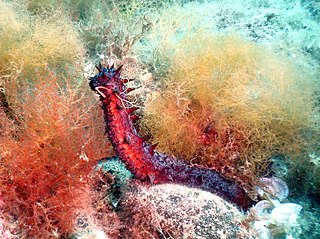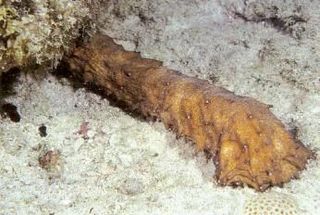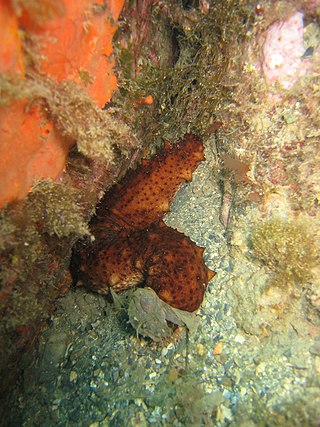
An echinoderm is any deuterostomal animal of the phylum Echinodermata, which includes starfish, brittle stars, sea urchins, sand dollars and sea cucumbers, as well as the sessile sea lilies or "stone lilies". While bilaterally symmetrical as larvae, as adults echinoderms are recognisable by their usually five-pointed radial symmetry, and are found on the sea bed at every ocean depth from the intertidal zone to the abyssal zone. The phylum contains about 7,600 living species, making it the second-largest group of deuterostomes after the chordates, as well as the largest marine-only phylum. The first definitive echinoderms appeared near the start of the Cambrian.

Holothuria is the type genus of the marine animal family Holothuriidae, part of the class Holothuroidea, commonly known as sea cucumbers. Members of the genus are found in coastal waters in tropical and temperate regions. They are soft-bodied, limbless invertebrates which dwell on the ocean floor and are usually detritivores. They resemble a cucumber in form. The genus contains some species that are harvested and sold as food.

Holothuria atra, commonly known as the black sea cucumber or lollyfish, is a species of marine invertebrate in the family Holothuriidae. It was placed in the subgenus Halodeima by Pearson in 1914, making its full scientific name Holothuria (Halodeima) atra. It is the type species of the subgenus.

Lanice conchilega, commonly known as the sand mason worm, is a species of burrowing marine polychaete worm. It builds a characteristic tube which projects from the seabed, consisting of cemented sand grains and shell fragments with a fringe at the top.

Holothuria forskali, the black sea cucumber or cotton-spinner is a species of sea cucumber in the family Holothuriidae. It is found at shallow depths in the eastern Atlantic Ocean and the Mediterranean Sea. It was placed in the subgenus Panningothuria by Rowe in 1969 and is the type taxon of the subgenus.

Holothuria scabra, or sandfish, is a species of sea cucumber in the family Holothuriidae. It was placed in the subgenus Metriatyla by Rowe in 1969 and is the type species of the subgenus. Sandfish are harvested and processed into "beche-de-mer" and eaten in China and other Pacific coastal communities.

Holothuria tubulosa, the cotton-spinner or tubular sea cucumber, is a species of sea cucumber in the family Holothuriidae. It is the type species of the genus Holothuria and is placed in the subgenus Holothuria, making its full name Holothuria (Holothuria) tubulosa.

Holothuria thomasi, the tiger's tail, is a species of sea cucumber in the family Holothuriidae. Although it is the largest sea cucumber known in the western Atlantic Ocean, it is so well camouflaged that it was 1980 before it was first described. It is placed in the subgenus Thymiosycia making its full name Holothuria (Thymiosycia) thomasi.
Holothuria spinifera, the brown sandfish, is a species of sea cucumber in the family Holothuriidae. It is placed in the subgenus Theelothuria, making its full name Holothuria (Theelothuria) spinifera. In India it is known as cheena attai or raja attai. It lives in tropical regions of the west Indo-Pacific Ocean at depths ranging from 32 to 60 metres. It is fished commercially to produce beche-de-mer.

Apostichopus japonicus is a species of sea cucumber in the family Stichopodidae. It is found in shallow temperate waters along the coasts of south east Asia and is commonly known as the Japanese spiky sea cucumber or the Japanese sea cucumber.

Holothuria floridana, the Florida sea cucumber, is a species of marine invertebrate in the family Holothuriidae. It is found on the seabed just below the low tide mark in Florida, the Gulf of Mexico, the Bahamas and the Caribbean.

Holothuria edulis, commonly known as the edible sea cucumber or the pink and black sea cucumber, is a species of echinoderm in the family Holothuriidae. It was placed in the subgenus Halodeima by Pearson in 1914, making its full scientific name Holothuria (Halodeima) edulis. It is found in shallow water in the tropical Indo-Pacific Ocean.

Condylactis aurantiaca, commonly known as the golden anemone, is a species of sea anemone in the family Actiniidae. This species always remains largely buried in sand or sediment, attached to the substrate, with only the oral disc and tentacles visible.

Holothuria fuscocinerea, the ashy pink sea cucumber, is a species of sea cucumber in the family Holothuriidae. It is placed in the subgenus Stauropora, making its full name Holothuria (Stauropora) fuscocinerea. It is native to shallow water in the tropical and sub-tropical Indo-Pacific.

Paraleptopentacta elongata is a species of sea cucumber in the family Cucumariidae. It is found in the northeastern Atlantic Ocean and parts of the Mediterranean Sea. It is an infaunal species, occupying a burrow in the seabed, from which its anterior and posterior ends project.

Thyone roscovita is a species of sea cucumber in the family Phyllophoridae. It is found on gravel, sand and mud substrates in the north-eastern Atlantic Ocean and the Mediterranean Sea at depths down to about 40 m (130 ft). It is a suspension feeder and catches food particles floating past with its branched feeding tentacles.

Actinopyga varians, the Pacific white-spotted sea cucumber or Hawaiian sea cucumber, is a species of sea cucumber in the family Holothuriidae. It is found in the Pacific Ocean near Hawaii and also in the Indo-Pacific Ocean.

Holothuria stellati, also known as the Brown sea cucumber,is a species of sea cucumber in the family Holothuriidae. First described by Delle Chiaje in 1824. There are two accepted subspecies, Holothuria stellatidakarensis and Holothuria stellati mammata, though there is still debate on whether or not they are separate species.
Holothuria (Selenkothuria) glaberrima, also known as the brown rock sea cucumber, is a species of sea cucumber in the genus Holothuria, subgenus Selenkothuria. The cucumber is distributed in the Western Atlantic Ocean, the Caribbean Sea, and the Gulf of Mexico. The species is found at a depth of 0–42 meters.

Holothuria (Thymiosycia) impatiens, commonly known as the impatient sea cucumber or bottleneck sea cucumber, is a species of sea cucumber in the genus Holothuria, subgenus Thymiosycia.



















